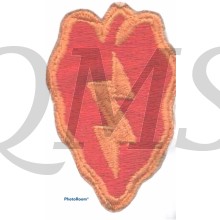Mouwembleem 25th Infantry Division (Sleeve patch 25th Infantry Division)
The 25th Infantry Division (nicknamed "Tropic Lightning", "Electric Strawberry", and the Củ Chi National Guard during the Vietnam War) is a U.S. Army division based in Hawaii. The division, which was activated on 1 October 1941 in Hawaii, conducts military operations in the Asia-Pacific region. Its present deployment is composed of Stryker, light infantry, airborne, and aviation units.
The 25th Division was formed from the 27th and 35th Infantry regiments of the original Hawaiian Division. This was a pre-second World War "square division" composed of four infantry regiments. The remaining units of the Hawaiian Division were reorganized as the 24th Infantry Division. These steps, part of the Triangular Division TO&E, were undertaken to provide more flexible orders of battle composed of three regiments.
After the Japanese air attack on Schofield Barracks, 7 December 1941, the 25th Infantry Division moved to beach positions for the defense of Honolulu and Ewa Point. Following intensive training, the 25th began moving to Guadalcanal, 25 November 1942, to relieve Marines near Henderson Field. First elements landed near the Tenaru River, 17 December 1942, and entered combat, 10 January 1943, participating in the seizure of Kokumbona and the reduction of the Mount Austen Pocket in some of the bitterest fighting of the Pacific campaign. The threat of large enemy attacks caused a temporary withdrawal, but Division elements under XIV Corps control relieved the 147th Infantry and took over the advance on Cape Esperance. The junction of these elements with Americal Division forces near the cape, 5 February 1943, ended organized enemy resistance.
A period of garrison duty followed, ending 21 July: On that date, advance elements debarked on Munda, New Georgia. The 25th Infantry, under the Northern Landing Force, took part in the capture of Vella Lavella, 15 August to 15 September 1943. Meanwhile, other elements landed on New Georgia, took Zieta, marched through jungle mud for 19 days, and captured Bairoko Harbor, winning the island. Elements cleared Arundel Island, 24 September 1943, and Kolombangara island with its important Vila Airport, 6 October. Organized resistance on New Georgia ended, 25 August, and the division moved to New Zealand for rest and training, last elements arriving on 5 December. The 25th was transferred to New Caledonia, 3 February-14 March 1944, for continued training.
The division landed in the San Fabian area of Luzon, 11 January 1945, to enter the struggle for the liberation of the Philippines. It drove across the Luzon Central Plain, meeting the enemy at Binalonan, 17 January. Moving through the rice paddies, the 25th occupiedUmingan, Lupao, and San Jose and destroyed a great part of the Japanese armor on Luzon. On 21 February, the division began operations in the Caraballo Mountains. It fought its way along Highway No. 5, taking Digdig, Putlan, and Kapintalan against fierce enemy counterattacks and took Balete Pass, 13 May, and opened the gateway to the Cagayan Valley, 27 May, with the capture of Santa Fe. Until 30 June, when the division was relieved, it carried out mopping-up activities. On 1 July, the division moved to Tarlac for training, leaving for Japan, 20 September.
The division's rapid movements during its campaigns led to the adoption of the nickname Tropic Lightning. It remained on occupation duty in Japan for the next five years.



